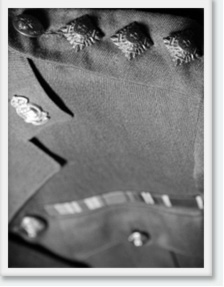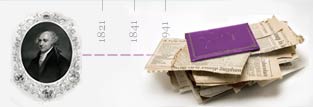Armed Forces & World Wars
British Armed Forces
World Wars
The British Army

The Army is divided into two types of soldiers: officers and other ranks.
Officers receive a commission from the sovereign and may be regarded as being senior and middle management. Less than 10 per cent of the British Army during the two world wars was made up of officers.
The vast majority of men in the Army were ordinary soldiers, known as privates, led by non-commissioned officers (NCO) many of whom had rather more experience and ability than the officers nominally in charge. The wise officer relied heavily upon his NCOs who many people have said are the 'backbone of the Army'.
Traditionally it was difficult for ordinary soldiers and NCOs to be commissioned as officers, although the appalling rate of casualties among officers during the First World War meant that increasingly this changed although there was considerable snobbery about these 'temporary gentlemen'. During the Second World War most officers were commissioned after a period in the ranks.
Junior officers may well have been promoted in the field, generally to replace more senior men who had been killed or wounded, and would have held a temporary rank one or two levels above their normal or substantive one.
Ranks
| Rank | Description |
|---|---|
| Private (Pte) | This is the lowest rank in the British Army consisting of ordinary soldiers. In the Royal Artillery he is known as a Gunner (Gnr); Royal Engineers - Sapper (Spr); Rifle Corps - Rifleman (Rfn); Labour Corps - Pioneer (Pnr); Guards regiments - Guardsman (Gdsm); Royal Fusiliers - Fusilier (Fus); Cavalry regiments/Tank Corps - Trooper (Tpr); Royal Electrical and Mechanical Engineers (REME) - Craftsman (Cfn); Royal Signal Corps - Signalman (Cfn); and Driver (Dvr) |
| Lance Corporal (L/Cpl) | Lance-Corporal was only an appointment rather than a rank, given to privates who were acting NCOs (known as a Lance Bombardier in the Royal Artillery, or Second Corporal in the Royal Engineers before 1920) |
| Corporal (Cpl) | In the infantry, led a section within a platoon (about 8-10 men). Known as a bombardier in the Royal Artillery. |
| Sergeant (Sgt) |
Sometimes spelt Serjeant, although this spelling was largely obsolete by the First World War although it appears on some war memorials. In infantry regiments he was second in charge of a platoon (about 30 men) to the platoon commander. In the Household Cavalry, sergeants were known as Corporal of Horse |
| Staff Sergeant (SSgt) | Known in the infantry as Company Quartermaster Sergeant (CQMS) or Squadron Quartermaster Sergeant (SQMS). |
| Warrant Officer II (WOII) | Known as Company Sergeant Major (CSM) in infantry regiments; Battery Sergeant Major (BSM) in the Artillery |
| Warrant Office I (WOI) | The Regimental Sergeant Major (RSM) who was responsible for all aspects of discipline and duty of Other Ranks |
Officers
Officers up to the rank of Brigadier are sometimes referred to as field officers, those above are general officers. Junior officers, particularly Second Lieutenants, are often referred to as Subalterns.
| Rank | Description |
|---|---|
| Second Lieutenant (2/Lt or 2Lt) | Normally in charge or second in charge of a platoon (that is 30 men) in the infantry or the equivalents in the Artillery and Engineers. The rank was introduced in 1871, before then it was known as Ensign or Cornet (in the cavalry) |
| Lieutenant (Lt) | Normally a platoon or platoon level commander |
| Captain (Capt) | Normally second in command of a company, battery (Royal Artillery) or squadron (of tanks or cavalry) (that is roughly 100 men) |
| Major (Maj) | Officer in charge of a company |
| Lieutenant Colonel (Lt Col) | Officer in charge of a battalion (that four to ten companies) |
| Colonel (Col) | Officer in charge of a battalion (that four to ten companies) or second in commander of a brigade |
| Brigadier (General) (Brig) | Officer in charge of a brigade (that is two battalions). The rank of Brigadier General was abolished after the First World War. |
| Major General (Maj Gen) | A Major General normally commanded a division (that is four or more brigades). The division was the most important formation in the Army. |
| Lieutenant General (Lt Gen) | A Lieutenant General normally commanded a corps (that is two or more infantry divisions, together with additional Artillery, Engineer and support formations) |
| General (Gen) | A General commanded an army |

